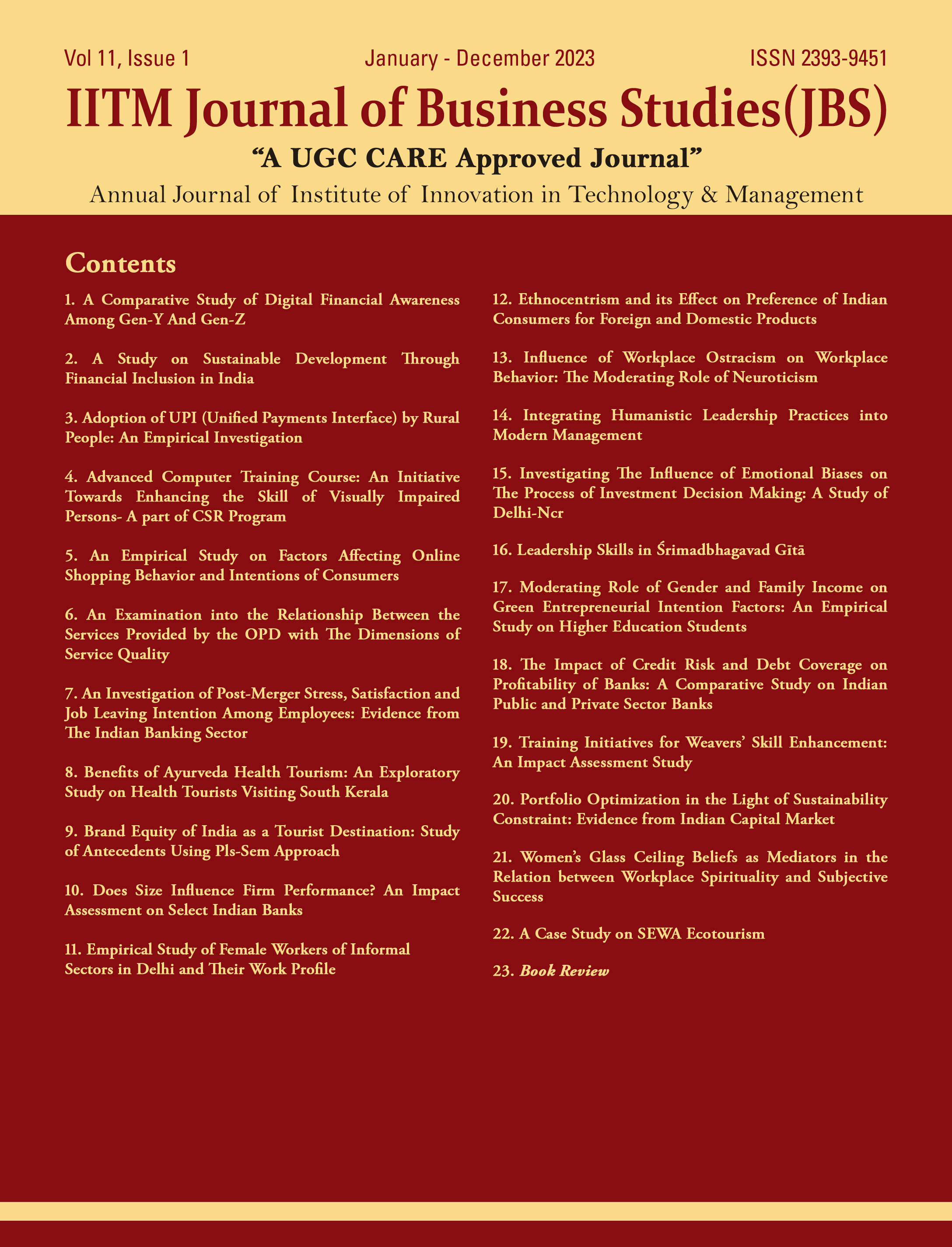An Empirical Study on Factors Affecting Online Shopping Behavior and Intentions of Consumers
Keywords:
Online shopping behavior, onsumer behavior, e-commerce, online shopping intentionAbstract
Online shopping has become a recent phenomenon in the field of electronic business and has gained familiarity among consumers around the world. Most of the companies are now adopting online portals to sell their products/services online. Though in countries like India, the trend of online shopping took some time to develop, but now a days, there is a craze for online shopping both among the younger and elderly populations. Compared to traditional store shopping, online shopping has received much more attention. The purpose of this study is to determine the driving factors affecting the online buying behavior of consumers and to analyze the impact of these driving factors on online buying intentions. To meet the research objectives, multiple regression analysis has been applied. The results of the study revealed that in order of their impact size, the most significant predictors of online buying behavior are convenience, impulse buying behavior, congruence, shopping enjoyment, browsing enjoyment, value consciousness, price consciousness and risk. The research provides a novel finding of the strongest effect of impulse buying behavior, which has not previously
been identified as a key antecedent to online shopping.
References
Ahuja, M., Gupta, B., & Raman, P. (2003). An empirical investigation of online consumer purchasing behavior. Communications of the ACM, 46(12), 145–151. https://doi.org/10.1145/953460.953494 2. Al-Bazaiah, S. (2022). Customer satisfaction towards online shopping in Jordan. Journal of Digitainability, Realism & Mastery (DREAM), 1(02), 42–47. https://doi.org/10.56982/journalo.v1i02.20 3. Babin, B. J., Darden, W. R., & Griffin, M. (1994). Work and/or fun: Measuring hedonic and utilitarian shopping value. Journal of Consumer Research, 20(4), 644. https://doi.org/10.1086/209376 4. Beatty, S. E., & Ferrell, E. M. (1998). Impulse buying: Modeling its precursors. Journal of Retailing, 74(2), 169–191. https://doi.org/10.1016/S0022-4359(99)80092-X
Bettman, J. R. (1973). Perceived risk and its components: A model and empirical test. Journal of Marketing Research, 10(2), 184–190. https://doi.org/10.1177/002224377301000209 6. Bucko, J., Kakalejčík, L., & Ferencová, M. (2018). Online shopping: Factors that affect consumer purchasing behaviour. Cogent Business & Management, 5(1), 1535751. https://doi.org/10.1080/233 11975.2018.1535751
Chang, S.-H., Chih, W.-H., Liou, D.-K., & Yang, Y.-T. (2016). The mediation of cognitive attitude for online shopping. Information Technology & People, 29(3), 618–646. https://doi.org/10.1108/ ITP-08-2014-0172
Han, F., & Li, B. (2021). Exploring the effect of an enhanced e-commerce institutional mechanism on online shopping intention in the context of e-commerce poverty alleviation. Information Technology & People, 34(1), 93–122. https://doi.org/10.1108/ITP-12-2018-0568
Khalifa, M., & Liu, V. (2007). Online consumer retention: Contingent effects of online shopping habit and online shopping experience. European Journal of Information Systems, 16(6), 780–792. https:// doi.org/10.1057/palgrave.ejis.3000711
Li, H., Kuo, C., & Rusell, M. G. (2006). The impact of perceived channel utilities, shopping orientations, and demographics on the consumer’s online buying behavior. Journal of Computer-Mediated Communication, 5(2). https://doi.org/10.1111/j.1083-6101.1999.tb00336.x
Lichtenstein, D. R., Ridgway, N. M., & Netemeyer, R. G. (1993). Price perceptions and consumer shopping behavior: A field study. Journal of Marketing Research, 30(2), 234–245. https://doi. org/10.1177/002224379303000208
Maher J. K., Lawrence J. M., & Pamela E. G. (1997). Overload, pressure, and convenience: Testing a conceptual model of factors influencing women’s attitudes toward, and use of, shopping channels. Advances in consumer research. Association for Consumer Research, 24, 490-498.
Mallapragada, G., Chandukala, S. R., & Liu, Q. (2016). Exploring the effects of “what” (Product) and “where” (Website) characteristics on online shopping behavior. Journal of Marketing, 80(2), 21–38. https://doi.org/10.1509/jm.15.0138
Mokha, A. K. (2021). Brand equity, brand satisfaction, and brand loyalty: A study of select e-commerce industry. International Journal of Online Marketing, 11(3), 34–50. https://doi.org/10.4018/ IJOM.2021070103
Mudambi & Schuff. (2010). Research note: What makes a helpful online review? A study of customer reviews on amazon. Com. MIS Quarterly, 34(1), 185. https://doi.org/10.2307/20721420 16. O’Guinn, T. C., & Faber, R. J. (1989). Compulsive buying: A phenomenological exploration. Journal of Consumer Research, 16(2), 147. https://doi.org/10.1086/209204
Papagiannidis, S., Pantano, E., See-To, E. W. K., Dennis, C., & Bourlakis, M. (2017). To immerse or not? Experimenting with two virtual retail environments. Information Technology & People, 30(1), 163–188. https://doi.org/10.1108/ITP-03-2015-0069
Park, E. J., Kim, E. Y., Funches, V. M., & Foxx, W. (2012). Apparel product attributes, web browsing, and e-impulse buying on shopping websites. Journal of Business Research, 65(11), 1583–1589. https:// doi.org/10.1016/j.jbusres.2011.02.043
Pascual-Miguel, F. J., Agudo-Peregrina, Á. F., & Chaparro-Peláez, J. (2015). Influences of gender and product type on online purchasing. Journal of Business Research, 68(7), 1550–1556. https://doi. org/10.1016/j.jbusres.2015.01.050
Rahman, M. A., Islam, Md. A., Esha, B. H., Sultana, N., & Chakravorty, S. (2018). Consumer buying behavior towards online shopping: An empirical study on Dhaka city, Bangladesh. Cogent Business & Management, 5(1), 1514940. https://doi.org/10.1080/23311975.2018.1514940
Raju, P. S. (1980). Optimum stimulation level: Its relationship to personality, demographics, and exploratory behavior. Journal of Consumer Research, 7(3), 272. https://doi.org/10.1086/208815 22. Raman, P. (2019). Understanding female consumers’ intention to shop online: The role of trust, convenience and customer service. Asia Pacific Journal of Marketing and Logistics, 31(4), 1138–1160. https://doi.org/10.1108/APJML-10-2018-0396
Vaghela, P. (2017). Factors affecting online shopping behavior in Surat city. International Journal of Marketing and Technology, 200-210.
Veerakumar, K. (2016). A Research on Quality Factors Influencing Online Shopping. International Journal of Engineering Research and Modern Education, 1(2), 1-5.
Venkatesh, V., Speier-Pero, C., & Schuetz, S. (2022). Why do people shop online? A comprehensive framework of consumers’ online shopping intentions and behaviors. Information Technology & People, 35(5), 1590–1620. https://doi.org/10.1108/ITP-12-2020-0867
Wagner, G., Schramm-Klein, H., & Steinmann, S. (2020). Online retailing across e-channels and e-channel touchpoints: Empirical studies of consumer behavior in the multichannel e-commerce environment. Journal of Business Research, 107, 256–270. https://doi.org/10.1016/j.jbusres.2018.10.048
Workman, J. E., & Cho, S. (2013). Gender, fashion consumer group, need for touch and Korean apparel consumers’ shopping channel preference: Korean apparel consumers. International Journal of Consumer Studies, 37(5), 522–529. https://doi.org/10.1111/ijcs.12017
Wu, W., Huang, V., Chen, X., Davison, R. M., & Hua, Z. (2018). Social value and online social shopping intention: The moderating role of experience. Information Technology & People, 31(3), 688–711. https://doi.org/10.1108/ITP-10-2016-0236
